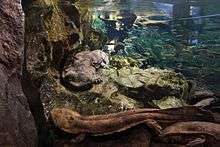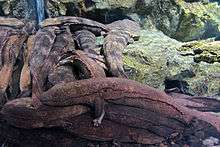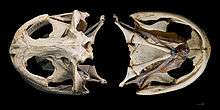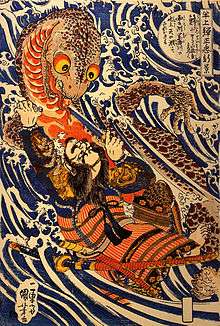Japanese giant salamander
The Japanese giant salamander (Andrias japonicus) is a species of salamander in the family Cryptobranchidae. The species is endemic to Japan, where it is known as Ōsanshōuo (オオサンショウウオ/大山椒魚), literally meaning "giant pepper fish". With a length of up to 5 feet (1.5 m),[3] it is the third-largest salamander in the world, only being surpassed by the very similar and closely related Chinese giant salamander (A. davidianus) and South China giant salamander (A. sligoi). There are currently only five known members of the family Cryptobranchidae: the Japanese, Chinese, and South China giant salamanders, an undescribed Andrias species from eastern China, and the hellbender (Cryptobranchus alleganiensis).
| Japanese giant salamander | |
|---|---|
 | |
| In Kyoto Aquarium | |
| Scientific classification | |
| Kingdom: | Animalia |
| Phylum: | Chordata |
| Class: | Amphibia |
| Order: | Urodela |
| Family: | Cryptobranchidae |
| Genus: | Andrias |
| Species: | A. japonicus |
| Binomial name | |
| Andrias japonicus (Temminck, 1836) | |
| Synonyms[2] | |
| |
Japanese giant salamanders are widespread across rivers in southwestern Japan. The species frequently hybridizes with Chinese giant salamanders, which were introduced to the area.
Description
The Japanese giant salamander can grow to a length of 5 feet (1.5 m) and a weight of 55 pounds (25 kg). The largest wild specimen on record weighed 58 lb (26.3 kg) and was 4.46 ft (136 cm) long.[4] It is the second largest amphibian in the world, only smaller than its close relative, the Chinese giant salamander. The brown and black mottled skin of A. japonicus provides camouflage against the bottoms of streams and rivers. It has very small eyes with no eyelids and poor eye sight. Its mouth extends across the width of its head, and can open to the width of its body.[5]
A. japonicus possesses large skin folds on its neck that effectively increase its overall body surface area. This assists in epidermal gas exchanges, which in turn regulates carbon dioxide and oxygen exchange with the water. Capillaries in the surface of the skin facilitate this gas exchange.[6]
The Japanese giant salamander can be distinguished from the Chinese giant salamander by the arrangement of tubercles on the head and throat. The tubercles are larger and more numerous compared to the mostly single and irregularly scattered tubercles of the Chinese giant salamander. The snout is also more rounded, and the tail is slightly shorter.[7]
There is no visual external sexual dimorphism.[7]
Behavior


The Japanese giant salamander is restricted to streams with clear, cool water. Due to its large size and lack of gills, it is confined to flowing water where oxygen is abundant.[8] it is entirely aquatic and almost entirely nocturnal. Unlike other salamanders, which lose their gills early in their lifecycles, it only breaches its head above the surface to obtain air without venturing out of the water and onto land. The salamander absorbs oxygen through its skin, which has many folds to increase surface area.[5]
When threatened, the Japanese giant salamander can excrete a strong-smelling, milky substance with an odor resembling Japanese pepper (hence its common Japanese name, giant pepper fish). It has very poor eyesight, and possesses special sensory cells covering its skin, running from head to toe, the lateral line system. These sensory cells' hair-like shapes detect minute vibrations in the environment, and are quite similar to the hair cells of the human inner ear. This feature is essential for hunting prey due to its poor eyesight.
It feeds mainly on insects, frogs and fish. It has a very slow metabolism and can sometimes go for weeks without eating.[5] It lacks natural competitors. It is a long-lived species, with the captive record being an individual that lived in the Natura Artis Magistra, the Netherlands, for 52 years.[3] In the wild, it may live for nearly 80 years.
Lifecycle
The Japanese giant salamander remains in bodies of water its entire life. During mating season in late August, sexually mature adults go upstream into the mountains to spawn and lay eggs. Large males guard a den and are known as denmasters. They mate with several females throughout the season. Smaller males who do not have a den may attempt to enter the den and fertilize some of the eggs. The male releases milt over the eggs laid by the female. The denmaster displays parental care by guarding the eggs and fanning water over them with his tail to increase oxygen flow.[9] Larvae emerge from the fertilized eggs. The larvae then develop gills and limbs, then lose their gills once they metamorphose into adults.
The Asa Zoo of Japan was the first organization to successfully breed Japanese giant salamanders in captivity. Several of their offspring were given to the National Zoo of the United States to establish a breeding program.[10] The Hanzaki Institute of Japan has since successfully bred Japanese giant salamanders using the Asa zoo's methods of creating artificial dens.
History
The Japanese giant salamander was first catalogued by Europeans when the resident physician of Dejima Island in Nagasaki, Philipp Franz von Siebold, captured an individual and shipped it back to Leiden in the Netherlands, in the 1820s. The species was designated as a special natural monument in 1951, and is federally protected.[11]
Status
The Japanese giant salamander is threatened by pollution, habitat loss (among other changes, by the silting up of the rivers where it lives), and overcollection. River disturbance has led to fewer appropriate nesting sites and dams block migration paths. It is considered Near Threatened by IUCN, and is included on CITES Appendix I.[12] It can be found on the islands of Kyushu, Honshu, and Shikoku in Japan. In the past, they were fished out of rivers and streams as a source of food, but hunting has ceased because of protection acts.
The Japanese giant salamander has been federally protected as a special natural monument by the Japanese Agency for Cultural Affairs since 1952 due to its cultural and educational significance.[13]
Cultural references

The Japanese giant salamander has been the subject of legend and artwork in Japan, for example, in the ukiyo-e work by Utagawa Kuniyoshi. The well-known Japanese mythological creature known as the kappa may be inspired by the Japanese giant salamander.[14]
There is a giant salamander festival every year on August 8 in Yubara, Maniwa City, Okayama prefecture to honour the animal and celebrate its life. The giant salamanders are called "Hanzaki" in Yubara, due to the belief that even if they are ripped in half (han) they continue to survive. There are two giant salamander floats: a dark male and a red female.[15]
As of 2017, a picture book entitled "Zakihan" was also published in both Japanese and English wherein the main character is a "hanzaki" called "Zakihan".
See also
References
- Yoshio Kaneko, Masafumi Matsui. 2004 (2004). "Andrias japonicus". IUCN Red List of Threatened Species. 2004: e.T1273A3376261. doi:10.2305/IUCN.UK.2004.RLTS.T1273A3376261.en.
- "Amphibian Species of the World - Andrias japonicus (Temminck, 1836)". Research.amnh.org. Archived from the original on 2009-03-26. Retrieved 2010-02-04.
- Andrias japonicus - Amphibiaweb
- Tochimoto, pers. com>
- "Japanese Giant Salamander". Smithsonian National Zoological Park. Archived from the original on 2016-06-24. Retrieved 2016-06-13.
- "Andrias japonicus". Animal Diversity Web. Retrieved 2018-03-28.
- http://amphibiaweb.org/species/3859
- The Encyclopedia of Reptiles and Amphibians. Facts on File Inc. 1986. ISBN 0-8160-1359-4.
- Okada, Fukuda, Takahashi, Sumio, Yukihiro, Mizuki (12 November 2014). "Paternal care behaviors of Japanese giant salamander Andrias japonicus in natural populations". Journal of Ethology. 33: 1–7. doi:10.1007/s10164-014-0413-5.CS1 maint: multiple names: authors list (link)
- "Japanese Giant Salamanders at the Zoo". Smithsonian National Zoological Park. Archived from the original on 2016-06-29. Retrieved 2016-06-13.
- オオサンショウウオ (in Japanese). The Agency for Cultural Affairs. Retrieved 2011-09-24.
- "Salamander News (No. 5)" (PDF). ARKive. 2014. Retrieved 2008-09-19.
- Takahashi, Mizuki. "Giant Salamander Research". Bucknell University. Retrieved 2016-06-13.
- "River Monsters" programme 6 Series 3 directed by Duncan Chard, screened in UK on ITV1 14.02.2012 at 19.30
- "AltJapan: Hanzaki Matsuri Dakara". altjapan.typepad.com. Retrieved 2017-04-25.
Further reading
- Stejneger L (1907). Herpetology of Japan and Adjacent Territory. United States National Museum Bulletin 58. Washington, District of Columbia: Smithsonian Institution. xx + 577 pp. (Megalobatrachus japonicus, pp. 6–11).
- Temminck CJ (1836). Coup-d'oeil sur la Faune des Iles de la Sonde et de l'Empire du Japon. Discours préliminaire destiné à servir d'introduction à la Faune du Japon. Amsterdam: Müller. 30 pp. (Triton japonicus, new species). (in French).
External links
| Wikispecies has information related to Andrias japonicus |

- Andrias japonicus at CalPhotos
- Discovery Channel Video on the giant salamander
- BBC report
- Video I shot in Minoo, Osaka, Japan of Cryptobranchus japonicus, Japanese giant salamander
